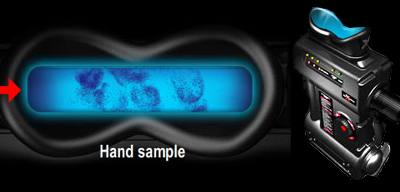Technology Born at UC San Diego Featured on CSI: Miami
By Kim McDonald, kmcdonald@ucsd.edu
San Diego, CA, April 28, 2008 -- A new way to detect explosives featured tonight on CBS’s popular show "CSI: Miami" had its origins in a UC San Diego chemistry laboratory.
|
William Trogler, professor of chemistry and biochemistry, and an academic participant in Calit2 at UCSD, developed the sensor ink for a portable explosives detection system. The XPAK was further developed and commercialized by the Rockville, Md.-based company RedXDefense.
In tonight’s episode, entitled "Tunnel Vision," the show's main characters will use the XPAK to help solve a crime. Viewers will be taken inside the device as the explosives detection occurs.
By detecting trace amounts of explosives on people, packages, vehicles and many other surfaces, the XPAK serves as a useful tool for gathering evidence on bomb-making facilities and bomb-makers.
The XPAK, which is currently deployed with the military and homeland security, uses a proprietary detection ink developed in Trogler’s laboratory and perfected by RedXDefense to achieve a simple, fast and inexpensive method to detect trace amounts of explosives. The technology, developed and exclusively licensed from UC San Diego, has many potential uses, including the detection of trace explosives fingerprints left by someone who has handled explosives and the detection of trace explosives on objects or vehicles.
Related Links
RedXDefense


